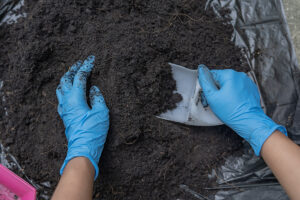 Soil is an essential part of plant growth, but not all soil is the same. The different kinds of soil available to you contain different combinations of organic and inorganic matter as well as minerals. The type of soil you use in your garden or landscape can have a significant effect on what plants you can successfully grow. Let’s discuss three of these six different types of soil, along with what you can do to offset their shortcomings.
Soil is an essential part of plant growth, but not all soil is the same. The different kinds of soil available to you contain different combinations of organic and inorganic matter as well as minerals. The type of soil you use in your garden or landscape can have a significant effect on what plants you can successfully grow. Let’s discuss three of these six different types of soil, along with what you can do to offset their shortcomings.
1. Sandy: High Drainage, Low Nutrients
This is a gritty type of soil. It drains easily and dries up rapidly. It’s a light soil that is easy to dig through, but it tends not to hold nutrients well since the quick drainage carries them away. Mulching is a great way to encourage sandy soil to retain water, and kelp meal or organic fertilizers can help add nutrients to help plants thrive. Some plants that do well in sandy soil are root vegetables, strawberries, tomatoes, squash, and hibiscus trees.
2. Clay: High Nutrients, Low Drainage
Clay is lumpy and sticky when wet and then becomes very hard when dry. While it can be rich in nutrients, it’s heavy, difficult to work with, and doesn’t drain well, making it harder for water to reach plant roots. To improve its permeability, you can work in compost, shredded leaves, or manure into the clay. Plants that can thrive in clay include summer vegetables, fruit trees, and several types of ornamental shrubs.
3. Silt: High Nutrients, High Drainage
Silt is made of small grains of quartz, between the size of sand and clay. This soil is nutrient-rich and is capable of holding moisture very well. However, this soil can erode or become compacted from moisture, so it’s important to monitor its drainage. To improve drainage, work compost into the soil. Many plants thrive in silt, from a wide variety of trees – like dogwoods, willows, birches, and cypresses – to nearly all fruits and vegetables, as long as proper drainage is maintained.
Now that you know three of the six different types of soil, you can determine if any of these are right for your garden’s or landscape’s needs. If you want to replace your current soil with a type that would better suit the needs of your landscape’s aesthetic, it can be hard work. At Dolan Landscaping, we have the necessary equipment to dig through tough soil and replace it with earth that better fits your needs. We can also commit to year-round landscape maintenance to keep your property looking lively. If you need help preparing your landscape this spring, contact us today.